List of 999 women of the Heritage Floor / Ištar
This list describes the place settings for Ištar on the table of the art installation The Dinner Party by Judy Chicago . It is part of the list of 999 women on the Heritage Floor who are assigned to the respective place settings on the table. The names of the 999 women are on the tiles of the Heritage Floor, which is arranged below the table and belongs to the art installation.
description
The installation consists of a three-sided table, each with 13 historical or mythological personalities, thus a total of 39 people, from prehistory to the women's rights movement . These people were assigned a place setting at the table, consisting of an individually designed table runner, an individually designed plate, a goblet, knife, fork, spoon and serviette. The first page of the table is devoted to prehistory up to the Roman Empire , the second to Christianization up to the Reformation and the third from the American Revolution to the women's movement. Each place setting on the table is assigned additional personalities who have received an entry on the tiles of the Heritage Floor, which occupies the space under the table and the center of the space between the sides of the table. This list includes the personalities assigned to the Ištar's table setting. Your seat is on the first side of the table.
Hints
In addition to the names as they are used in German transcription or in scientific usage, the list shows the spelling chosen by Judy Chicago on the tiles.
The information on women who do not yet have an article in the German-language Wikipedia is referenced by the individual references listed under comments . If individual information in the table is not referenced via the main article, additional individual references are given at the relevant point. If there are any discrepancies between the information provided in Wikipedia articles and the descriptions of the work of art on the Brooklyn Museum website , this will also be indicated under Comments.
Place setting for Ištar
Ištar is the Akkadian name of a Sumerian goddess worshipedin Mesopotamia . She was the goddess of war and the goddess of love and (sexual) desire, and she also had other attributes. The planet Venus , the morning and evening stars, was assigned to her. Ištar was considered the daughter of Sin and sister of Šamaš and was the most important female deity in the Akkadian pantheon. A gate in the walls of Babylon , the Ištar Gate , was named after her; a reconstruction of the gate is in the Pergamon Museum , Berlin .
She shared many aspects with a former Sumerian goddess, Inanna , also Inana. In addition, many lovers are attributed to her. Perhaps the best known myth of Ištar describes how she chose a young shepherd named Dumuzi (later called Tammuz) as her lover. They were later joined by the ritual "holy marriage". Shortly afterwards, Dumuzi died. In other myths, Ištar controls thunderstorms and rain, wages war in the divine world and steals the self from the god Enki .
One of the rituals associated with the worship of Ištar is the “holy marriage” in which a male ruler identifies with Dumuzi. Since the practice has only been described in the literature, it is unclear whether it was a purely symbolic or an actual repetition. She is said to have supported preferred rulers in battle, as evidenced by artistic representations and texts. It was on this help that kings established their rule.
In the art installation, Ištar is connected with architectural motifs. The geometric shapes of its runner come from the Ištar gate and the earlier ziggurat of Ur , which is dedicated to the moon god Nanna , who, according to tradition, was the divine father of Ištar. The ascending steps next to the name on the table runner simulate the ascending steps of the ziggurat, the inside of the upper arch, made in brick, is a reference to the tiles of the Ištar Gate. The architectural motifs are intended to indicate the progress of civilization and the relationship to the worship of the goddess, who was strengthened in society through better organization. The table runner is bordered with a black braid, reminiscent of the technique of braiding.
The color design of the plate and the table runner with gold tones and green reflections was called the Ištar colors. Gold is supposed to represent their size and remind of the color of Mesopotamian architecture and landscape. Green is the sacred color of the Ištar. She is depicted on the plate as a positive creator with several breast-like shapes that are intended to indicate her role as a giver of life.
Since Ištar is usually identified as the later form of Inanna, a Sumerian goddess, there are many similarities between her myths and artistic representations. The two are often seen as a goddess with a tradition. In much of the literature they are referred to as a single being. However, in the installation The Dinner Party , Judy Chicago decided to view them as two separate deities. Inanna can be found on the Heritage Floor as one of the names assigned to the Ishtar.
| Surname | Spelling on the tile | Date of birth | cultural spatial assignment | Remarks | image |
|---|---|---|---|---|---|
| Amat-mamu | Amat-Mamu | around 1750 BC Chr. | Mesopotamia , Old Babylonian Period | Priestess and writer, lived as Nadītu in the Sippar of Babylon and reached a great age. | |
| Anahita | Anahita | N / A | Persian mythology | Goddess of water and at the same time of fertility as well as the deification of the “world river” that feeds the cosmic ocean. |

|
| Anath | Anath | N / A | Egyptian mythology | Goddess of war, protective goddess against wild animals. In addition to her role as the goddess of war, Anat also acted as the goddess of love. |
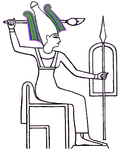
|
| Aphrodite | Aphrodite | N / A | Greek mythology | Goddess of love , beauty and sensual desire and one of the canonical twelve Olympian deities . |

|
| Arinna | Arinitti | N / A | Hittite mythology | The sun goddess of Arinna is the main goddess and wife of the weather god Tarḫunna in Hittite mythology . She led the kingdom and was considered the "queen of all countries". |
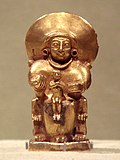
|
| Asherah | Asherah | N / A | Syriac - Canaanite goddess | Syriac-Canaanite sea goddess . Archaeological finds suggest that Israelites viewed Ashera as the wife of YHWH.
The work of art explains that she is to be equated with Athirat, the mother goddess of Ur . The practice of Hebrew women to bake small cakes in the shape of Asherah, to bless them and to eat them is described in the artwork as the basis for the host used in Catholic worship . |

|
| Astarte | Ashtoreth | N / A | West Semitic goddess | Queen of heaven and goddess of love for several West Semitic peoples.
In the artwork, she is described as Ashtoreth, who is identical to Asherah, Astarte and Ištar, who are all the manifestations of the same goddess but who were worshiped in different regions. Ashtoreth would have been the highest female deity of the Phoenicians, connected with Baal , responsible for love and fertility. |

|
| Astarte | Astarte | N / A | West Semitic goddess | Queen of heaven and goddess of love for several West Semitic peoples.
In the artwork, she is described as Astarte, who is identical to Ištar, Ashtoreth and Asherah and is the Phoenician goddess of love and fertility, and the patron saint of Sidon . She was Baal's partner . |
|
| Baranamtarra | Baranamtarra | 24th century BC Chr. | Mesopotamia , Sumer | Wife of the early dynastic king Lugalanda of Lagaš . |

|
| Blodeuwedd | Blodeuwedd | N / A | Celtic mythology | Female legendary figure from the Celtic mythology of Wales from the story Math fab Mathonwy . |
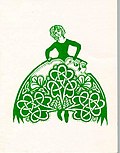
|
| Ceridwen | Cerridwen | N / A | Celtic mythology | Barley and moon goddess who symbolizes the continuous cycle of life and death. |

|
| Cybele | Cybele | N / A | Phrygia | Goddess who, together with her lover, Attis, was originally worshiped in Phrygia ( Asia Minor ) and later in Greece, Thrace and Rome. |
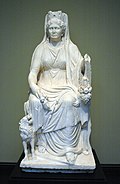
|
| En-hedu-anna | Encheduanna | about 2250 BC Chr. | Mesopotamia , Ur | En-hedu-anna was an Entu priestess , thus high priestess of the moon god Nanna in the southern Mesopotamian city of Ur and at the same time his wife. In addition to her important position in the country, she is considered the first historically known author whose works have been handed down in writing. |

|
| Ḫannaḫanna | Hannahanna | N / A | Hittite mythology | Her name means "great grandmother" (from Hittite ḫanna- = grandmother). She was equated with the Mesopotamian mother goddess Dingirmaḫ . | |
| Hathor | Hathor | N / A | Egyptian mythology | Mother goddess. She was also the goddess of the dead and goddess of love , peace, beauty, dance, art and music. |
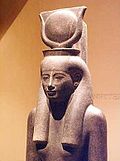
|
| Iltani | Iltani | around 1750 BC Chr. | Old Babylonian Empire | Queen of Karana, daughter of Sumu-Addu and sister of Amat-Šamaš , a Šamaš-Nadītum . | |
| Inanna | Inanna | N / A | Sumerian mythology | One of the great Sumerian goddesses under An or after taking possession of the Eanna sanctuary, also next to An. |

|
| Isis | Isis | N / A | Egyptian mythology | Goddess of birth , rebirth and magic , but also goddess of the dead. |

|
| Kubaba | Kubaba | N / A | Hittite mythology | Goddess worshiped by the Hittites . She was the city goddess of Karkemiš and was also called "Queen of Karkamiš". |
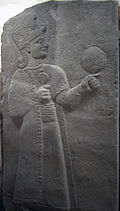
|
| Puabi | Shub-Ad of Ur | around 2500 BC Chr. | Mesopotamia , Sumer | Queen or lady-in-waiting who was buried in the royal cemetery of Ur . |

|
| Šibtu | Shibtu | around 1775 BC Chr. | Mesopotamia , Mari | Queen of Mari. Many boards of correspondence between Shibtu and her husband, King Zimri-Lim, survived, showing that she often administered the affairs of the kingdom. | |
| Tanite | Tanith | N / A | Punic mythology | The goddess of fertility , the main female deity of Carthage , replaced Astarte in this role. |

|
- Individual evidence
- ↑ Brooklyn Museum: Ishtar. In: brooklynmuseum.org. Retrieved September 29, 2019 .
- ↑ Brooklyn Museum: Amat-Mamu. In: brooklynmuseum.org. Retrieved September 22, 2019 .
- ↑ Brooklyn Museum: Asherah. In: brooklynmuseum.org. Retrieved November 17, 2019 .
- ↑ Brooklyn Museum: Ashtoreth. In: brooklynmuseum.org. Retrieved September 30, 2019 .
- ↑ Brooklyn Museum: Astarte. In: brooklynmuseum.org. Retrieved September 30, 2019 .
- ↑ Brooklyn Museum: Shibtu. In: brooklynmuseum.org. Retrieved September 30, 2019 .
Web links
- Brooklyn Museum, Ištar
- The Dinner Party on the website of Through the Flower , Judy Chicago's non-profit organization
